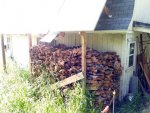Well, my nap didn't last long. One of my newer neighbors came over to get some water in liquid form.
We had 40+mph winds (64kph), and the temps were in the -18c range for you guys in metric-land. A little snow, but it was basically too cold for a big one. It was fairly exciting in a hard-work-to-keep-it-all-good sense. Around here, the antifreeze mix in autos doesn't save them from freezing below about 15f or so, so as part of the stuff I had to do late into the night, I ran both my vehicles to keep them (and their batteries) warm, "wasting" some gasoline. As well as heating my outdoors battery box via exhaust from the backup generator, even though the batteries were charged - you can freeze them, you know. It's not easy, but it's a huge expense if you manage to do that.
After paying ~$6k for them, I got kind of protective.
Forewarned is forearmed if you're a "word to the wise" type of guy. We tightened this place up considerably during the solar upgrade, and knowing this was coming, I put in a regular old gas/mantle lamp (on propane, a grill tank), installed in the basement of the building with the plumbing, to keep it warm, and did the "tighten it up", including screwing shut a hinged door to the basement/crawl space, since it leaked without some help forcing it to seal and flatten some warpage. That seemed to be the biggie, other than just trying to keep the indoors warm in a place that's pretty leaky (where I took the pic - it's a mobile home, my old office).
Last night, with a roaring fire that I'd kept that way since the early morning, it held 58f in there.
This AM it was 28F in there after reloading the fire at 2 AM. You can only put so much fuel in there, and past a point, I was unwilling to go out in that to re-fill the woodstove, and unwilling to run propane ($$$) which is manual controlled anyway - .
One of those cases where if you're near the stove, you have to rotate like a rotisserie or one side burns while the other freezes. But if you're ten feet away, you're cold.
My main building/shop has milling machines, lathes, steel stock etc - many tons worth. Once you get all that hot, you're good. Let yourself get behind, you're hosed. We are supposed to see a "high" of 16f today, with no wind. Whew! I'm expecting more help calls from neighbors to fix up their stuff, almost no one around here (other than the real old-timers) is ready for things like this as its so rare (here, that is, I'm sure those in the north/midwest are thinking "wuss" right now).
They think so, but when TSHTF, well, it's pretty serious if the fan is pointed at you and you made too many assumptions. Like what used to work still will. As my sig says in other places "Why
guess when you can
know?
Measure!"
Now that we are past winter solstice, I should be on here more. I've been in "hunker down" mode energy-wise for a bit, of late. Now things are already getting better fast for power.
Did pretty well on the Volt last year... It's hard to describe how badly that thing spoils you - driving for the cost of tire wear once the rest is set up. And it's no slug on the road.





